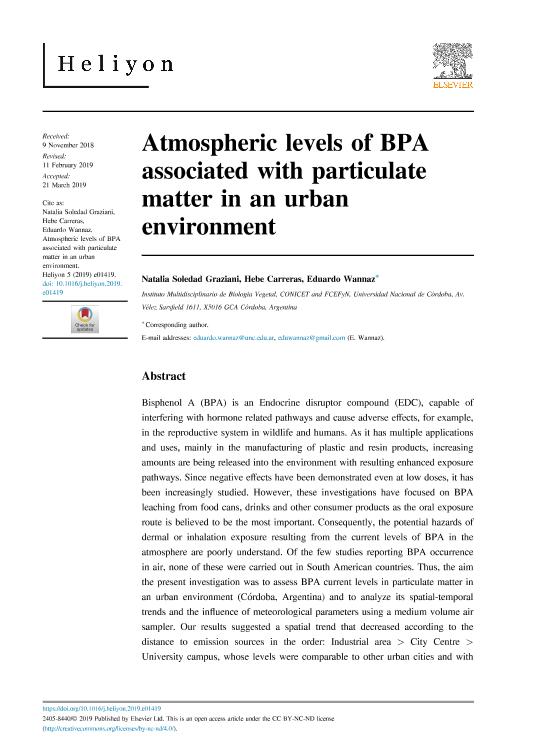Artículo
Atmospheric levels of BPA associated with particulate matter in an urban environment
Fecha de publicación:
04/2019
Editorial:
Elsevier Ltd
Revista:
Heliyon
e-ISSN:
2405-8440
Idioma:
Inglés
Tipo de recurso:
Artículo publicado
Clasificación temática:
Resumen
Bisphenol A (BPA) is an Endocrine disruptor compound (EDC), capable of interfering with hormone related pathways and cause adverse effects, for example, in the reproductive system in wildlife and humans. As it has multiple applications and uses, mainly in the manufacturing of plastic and resin products, increasing amounts are being released into the environment with resulting enhanced exposure pathways. Since negative effects have been demonstrated even at low doses, it has been increasingly studied. However, these investigations have focused on BPA leaching from food cans, drinks and other consumer products as the oral exposure route is believed to be the most important. Consequently, the potential hazards of dermal or inhalation exposure resulting from the current levels of BPA in the atmosphere are poorly understand. Of the few studies reporting BPA occurrence in air, none of these were carried out in South American countries. Thus, the aim the present investigation was to assess BPA current levels in particulate matter in an urban environment (Córdoba, Argentina) and to analyze its spatial-temporal trends and the influence of meteorological parameters using a medium volume air sampler. Our results suggested a spatial trend that decreased according to the distance to emission sources in the order: Industrial area > City Centre > University campus, whose levels were comparable to other urban cities and with the temporal trend showing a higher prevalence of the compound in the colder months. Wind speed (WS), temperature (T), atmospheric pressure (AP) and relative humidity (RL) were the most influenced variables. However daily values are unpredictable and depend mainly on the emission sources and punctual events that release BPA into the atmosphere. No risk factor could be quantified since there is no reference value for this exposure route; Nevertheless, this study represents the first approach and provides data about this emergent pollutant in and Argentinean city, thus contributing to global BPA studies.
Palabras clave:
ATMOSPHERIC SCIENCE
,
ENVIRONMENTAL SCIENCE
,
HEALTH SCIENCES
Archivos asociados
Licencia
Identificadores
Colecciones
Articulos(IMBIV)
Articulos de INST.MULTIDISCIPL.DE BIOLOGIA VEGETAL (P)
Articulos de INST.MULTIDISCIPL.DE BIOLOGIA VEGETAL (P)
Citación
Graziani, Natalia Soledad; Carreras, Hebe Alejandra; Wannaz, Eduardo Daniel; Atmospheric levels of BPA associated with particulate matter in an urban environment; Elsevier Ltd; Heliyon; 5; 4; 4-2019
Compartir
Altmétricas




